It’s natural to worry if your pet is off-color. After all, he can’t tell you what’s wrong. You can only go by the symptoms he is displaying. Of course, your first port of call if you think your dog is unwell is your veterinary surgery. But in the meantime, you may want to gather evidence to give your vet as full a picture of his symptoms as possible.
One sure sign that something’s up with your canine is if his temperature is above normal and he’s running a fever. Here, we look at the five best thermometers for dogs that you can buy on the market, as well as offering some handy tips on what to look for; when and how to use a thermometer; and how to treat a fever at home until you can get to your professional’s surgery.
The 8 Top-Rated Dog Thermometers to the Dog Owners
1 Advanced Monitors PT-300 Ear Thermometer For Dogs
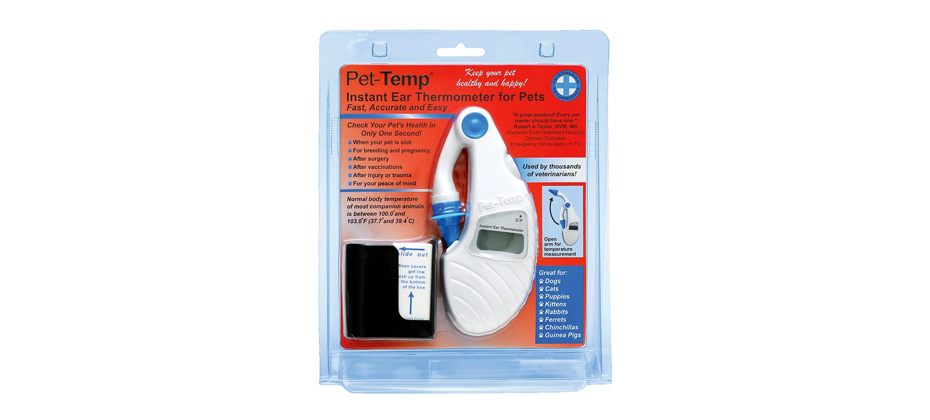
- In-ear thermometer
- Measures infra-red heat waves
- For use with disposable probe cover
- Veterinary-grade
A great choice if you’re looking for highly accurate readings, this thermometer for dogs is a vet-grade option. In other words, it’s perfect for those seeking the most accurate readings, as quickly as possible. Unfortunately, however, there have been some complaints about the battery life of this option. The company does offer a battery replacement service – but this comes with additional costs.
Ideal for dogs who aren’t too keen on more invasive thermometers, this option reads well within seconds. Even better, you don’t need to push it farther down the ear canal in order to get your accurate readings, either.
- Disposable covers provide excellent hygiene
- Highly accurate
- Easy to read measurements
- Provides reading within seconds
- The battery needs changing at their facility (with additional fees)
- Battery has a short lifespan
2 IProvèn Pet Thermometer
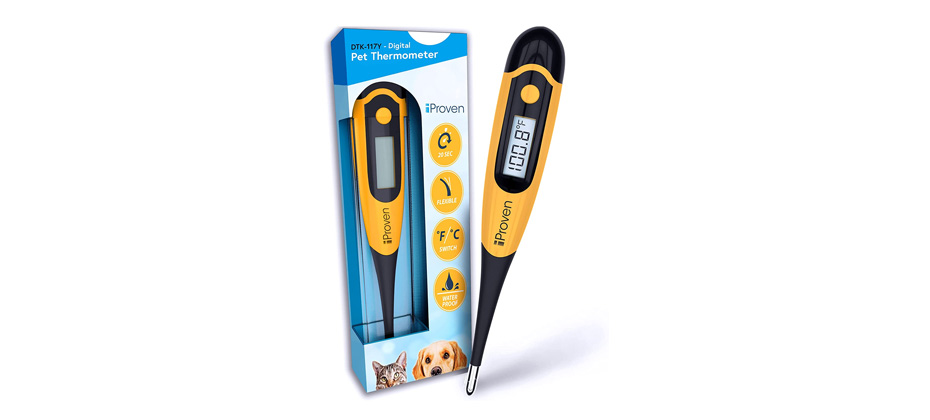
- Accuracy: +/- 0.2 degree
- Speed: about 20 seconds
- Site: rectal, oral and axillary
If you’re looking for an affordable, yet highly accurate dog thermometer, check out iProven Pet Thermometer. With a soft and flexible tip, this rectal digital thermometer is easy and pretty quick to use. It’s comfortable for the pet (even the super-wriggly ones won’t mind this thermometer much!) and gives results in about 20 seconds, which is pretty fast for a device that costs less than $15. The model is also waterproof, so easy to clean and maintain as well.
The iProven shows results either in Fahrenheit or Celsius, whichever works better for you. Because it has a simple design and comes in a hard case, the thermometer is not only easy to use, but store too. All you have to do is apply a little bit of petroleum jelly or baby oil to insert the probe more easily, and hold your pet so you can take a measurement. After you’re done using it, clean the thermometer and store it in its case – done! The only downside? Batteries do need to be changed often, but at least the product comes with batteries included.
- Reliable and accurate
- Waterproof and easy to clean
- Budget-friendly
- 100 day guarantee, no questions asked
- Batteries need to be changed often
3 MINDPET-MED Fast Clinical Pet Thermometer For Dogs
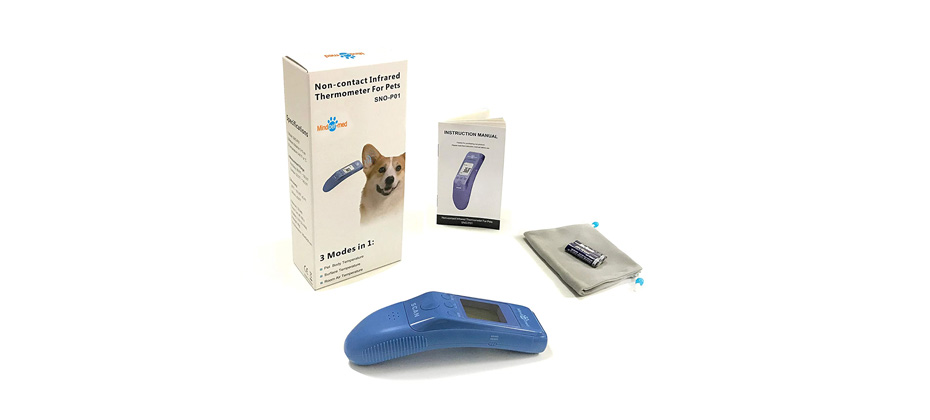
- Backlit LED display
- Reads in both Celsius and Fahrenheit
- No contact necessary
For those seeking more general temperature checks, to help maintain their dog’s overall health, this is a good option for your needs. Designed for dogs who aren’t keen on having probes inserted into their ears, this option uses infrared heat measurement, to provide you with a reading. Unfortunately, the distance can mean that accurate readings are less likely, as there are many variables, such as density of fur, for example.
However, it does provide quick results and offers dogs who are nervous an alternative. This might just be the right choice for your needs, if you rescue pups and need to get an indication of their overall wellbeing, for example. Or simply to see how your dog is doing from time to time.
- Ideal for nervous dogs as no contact is needed
- Provides results within 1 second
- Reads up to 40 degrees Celsius
- Can be used within 3-5cm of your dog
- Not as accurate as others on our list
- The noise can affect some dogs
4 KAMSAY Digital Dog Thermometer
- Accuracy: within 0.2 Fahrenheit (0.1 Celsius)
- Speed: about 10 seconds or longer
- Site: rectal, oral, axillary
Accurate, quick and comfortable to use, you can’t go wrong with Kamsay Thermometer. This digital device can be used for both babies and pets, as it’s perfectly safe and highly accurate. Thanks to its soft and flexible tip, it’s easy to insert too, which is especially beneficial when measuring rectally. It helps you don’t have to wait long to get the measurements – about 10 seconds is all it takes. The display is large and lighted, so you shouldnt; have any issues reading the measurements easily even in the dark. Another useful feature is dual measurement reading (both Celsius and Fahrenheit).
The Kamsay device is waterproof and should be cleaned after each use, just like any other thermometer. It can be used rectally, orally or axillary, but using it rectally is recommended as it gives the most accurate measurements. Thanks to its sturdy construction and protective case, it’s also easy to store. The only minus we could find is it doesn’t stay lit up once the reading has finalized.
- Can be used on humans and pets
- Quick and comfortable to use
- Waterproof for hygienic use
- Affordable, 1 year warranty
- Display doesn’t stay lit up for long
5 ADC Veterinary Thermometer
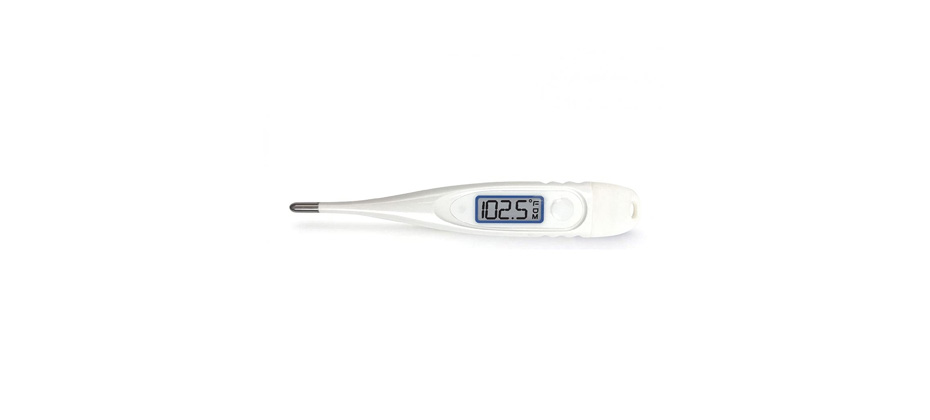
- Accuracy: to 0.3 degrees
- Speed: 10 – 60 seconds
- Site: rectal
Compact, cheap and easy to use, the ADC Veterinary Thermometer is just under 5 inches long, making it perfect for travel and easy storage. The device is specifically designed for veterinary purposes, so it can be used on dogs and other pets of all sizes and ages. It comes with a dual scale range of 90°F – 111.9°F, ±.2°F, or 32.0°C – 43.9°C, ±.1°C, providing accurate and quick results. That said, it’s certainly not the fastest thermometer out there – it takes anywhere between 10 to 60 seconds to accurately measure your pup’s temperature. The good thing is that it’s fairly easy to use as it’s specifically designed for use in animals.
This model comes in a handy carry case and includes five probe sheaths for hygienic use. The coin-type battery is also included and provides up to 1,500 measurements. Of course, it’s also replaceable, so when the battery flag starts blinking, it’s time to replace it.
- Affordable and easy to use
- Waterproof
- Comes with disposable sheaths
- Takes a while to read
6 AURYNNS Pet Thermometer
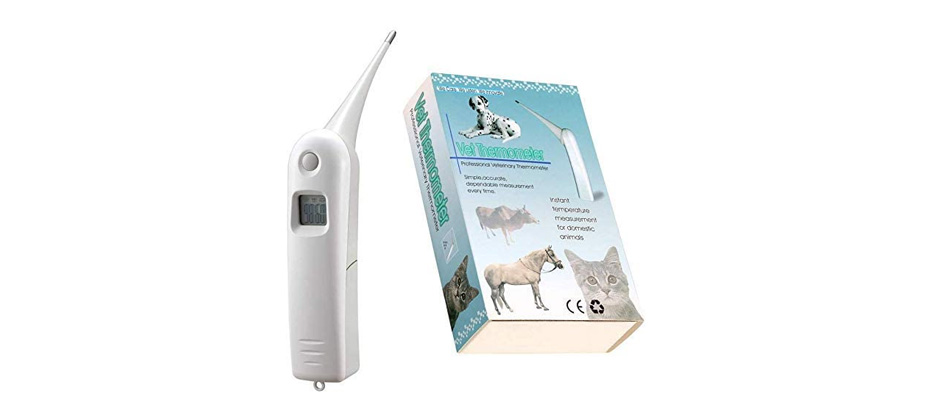
- For rectal use
- Reads up to 43 degrees Celsius
- LCD display
- Memory function
- Reads in both C and F
Switchable between Celsius and Fahrenheit, this option of dog thermometer will designed with regular use and livestock in mind. To be used rectally, it requires some know-how to help get the job done and isn’t ideal for those seeking an easy, quick reading for their pets at home. However, the probe is incredibly accurate and can even retain previous readings, so you can compare and make the necessary adjustments.
The LCD display is easy to read, while the maximum temperature reading is 43C, meaning you’ll always know the exact temperature – right up to the point that you need to call a veterinarian! Do be aware that the longer probe makes this unsuitable for smaller animals, and isn’t ideal for those who are inexperienced in taking rectal readings.
- Great price provides great value
- Ideal for livestock and larger animals
- Display is extremely easy to read
- Can take up to 15 seconds to gain a reading
- Not for inexperienced users
- Too long for smaller breeds
7 Hurinan Electronic Dog Thermometer
- Accuracy: +/- 0.2°F
- Speed: 30- 40 seconds
- Site: orally or rectally
Specifically designed to be used on pets and other animals, the Hurinan Animal Electronic Ehermometer is accurate and easy to use. Thanks to its small, 3-inch long probe, it’s not uncomfortable for the pet either, regardless of their size. The device is battery powered and comes with a large LCD that shows temperatures to +/- 0.2 F. Highly accurate, the device reads measurements either in Fahrenheit or Celsius and can be used both orally and rectally.
The Hurinan thermometer is easy to clean as well, as all you have to do is clean the tip with alcohol or soap after each use. While the manufacturer doesn’t specify exactly how long the device takes to measure the body temperature, most consumers agree it takes good 30-40 seconds.
- Quick and simple to use
- Large, easy-to-read LCD
- Warranty 90 days
- Takes a while to read the temperature
8 Aurynns Pet Thermometer For Dogs
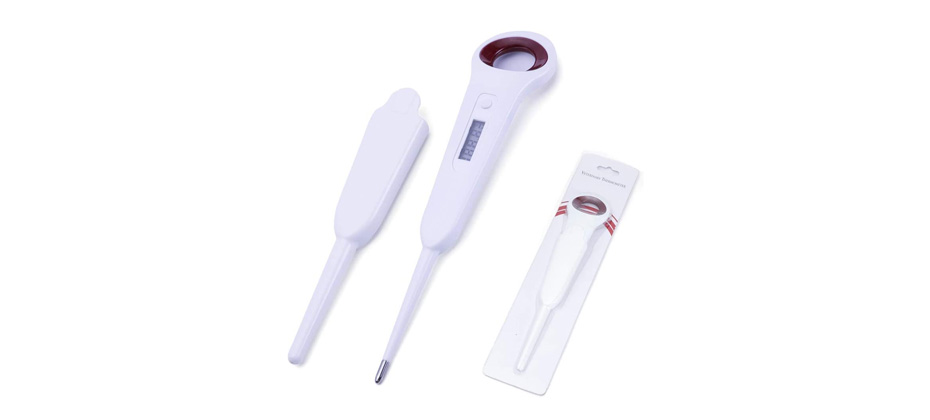
- Accuracy: +/-0.2 F
- Speed: around 20 seconds
- Site: orally or rectally
The Aurynns Pet Thermometer is veterinary approved, accurate and easy to use on a number of pets, including dogs, cats, horses, cows and other animals. With a simple, ergonomic design and small LCD, the device is easy to use even on fussy dogs and puppies as it’s comfortable both for you and the animal. It can be used either orally or rectally, and no matter which way you go, it takes about 20 seconds to record and display body temperature. Considering the affordable price, this is pretty quick!
While reliable and accurate, the model cannot switch between Fahrenheit and Celsius, which is something to keep in mind if you like to have both scale ranges on hand. There is an automatic shut-off feature though, which helps save battery life.
- Specifically designed for pets and animals
- Easy to use and clean
- Reliable and accurate
- May take longer to read the temperature from time to time
Best Dog Thermometers: Buying Guide
There are a few aspects to bear in mind if you’re looking for the right thermometer to take your precious pet’s temperature when he’s under the weather.
- Naturally, check the thermometer you’re thinking of buying is suitable for pets. Animals have a different ‘normal’ body temperature than humans, which we’ll go into in more detail below. Many cover both animals and humans; although for hygiene reasons, it’s suggested to have a separate unit for each species, at least!
- Take account of your pet’s nature and choose a thermometer that will cause him as little distress as possible. This may mean using a non-touch thermometer rather than one with a probe if he’s fussy about the type of contact you have with him!
- A waterproof design and backlit display are often popular options. The former prevents accidental damage and allows for best hygienic cleansing; the latter makes it a little easier to take a reading if you have a pet that’s struggling to get away.
- If you’re a professional in animal welfare, you will require a higher degree of accuracy than perhaps a pet owner will. Choose your thermometer accordingly.
With those factors in mind, we’ve rounded up the pick of the products in this category on the market.
What is a Normal Dog Temperature Range?
A dog’s normal temperature will fall between the range of 99.5oF (37.5oC) and 102.5oF (39.2oC). It’s important to remember that this is higher than humans’ average range, which for reference is between 97.6oF (36.4oC) and 99.6oF (37.6oC).
Any reading that you take that’s over 103oF (39.4oC) indicates that your dog has a fever. And if his body temperature is 106oF (41.1oC) or above,
it’s vital to note that this could well be life-threatening and emergency treatment should be sought from your vet. Excessively high temperatures can cause damage to the internal organs.
What are the Symptoms of a Dog With A Fever?

- There is truth in the old wives’ tale that a dog with a temperature will have a dry nose. The nose will also feel warm to the touch.
- Your dog’s ears may also feel warmer than usual.
- He may be listless, lethargic, and lacking in his usual bounce. He may also be off his food.
- His eyes may look red-rimmed.
- Other symptoms commonly include dehydration, excessive panting, rapid heart rate, shivering, coughing, and vomiting.
Different Types of Dog Thermometers

Standard glass human thermometers are not suitable for use on dogs, because they are not built to give accurate readings of canines’ higher temperatures. They can also be dangerous if your dog suddenly reacts adversely to the process and the thermometer snaps while inside him.
There are two main types of thermometer designed for use with dogs, which you can find online or in your local pet store.
- Thermometers with a probe that is inserted into either the anus (rectal thermometers) or ear (auricular thermometers). These are generally considered to offer more reliable results but can be intrusive and cause the dog to feel stressed.
- Infrared thermometers that work by being placed in close proximity to your pet, for example by their skin or the ear.
Thermometers are then described as being for rectal, axillary, and/or auricular use. The rectal thermometer will usually be the cheapest and is the most traditional option. It’s wise to have a friend or family member whom the dog likes to help with the process, as he may struggle. This is not only distressing, but can affect the reading.
Axillary thermometers take a reading from the dog’s armpit. They’re a fair option for dogs that won’t allow rectal temperatures to be taken but will not offer as precise a reading.
Auricular temperature readings are taken from the ear canal. As they use an infrared beam to measure the temperature by bouncing off the dog’s eardrum, which is a fair way down the ear, you will need to buy a thermometer specifically designed for dogs for this purpose. Ones suitable for use in humans will not have a suitably long probe. This makes them the most expensive of the three options, but many owners may prefer this to causing their dog any distress by attempting rectal measurements.
The accuracy of the temperature taken depends very much on the correct positioning of the thermometer, though, making the rectal option – though the least pleasant – still the most reliable of the three.
What Makes a Good Pet Thermometer
The common features of a good pet thermometer are as follows:
- Taking a reading should be as fast as possible, to avoid upsetting your pet.
- The thermometer should be easy to clean, for hygiene reasons. It must be capable of being disinfected thoroughly before each use and afterwards as well, so that viruses, germs, and bacteria are not transmitted onward.
- Accuracy, of course, is a critically important feature. This usually rules out older thermometers and makes digital thermometers the best choice. Older style, analog ones tend to offer less accurate readings, and when you’re talking about the difference between less than one degree in terms of sickness and health, results need to be as exact as possible.
Durability may also be a factor for you if you want to use the thermometer frequently, in the long term, and/ or are in the canine business – a breeder or groomer, for instance.
Finally, you should take into account your own temperament and that of your pet before purchasing a thermometer and use that to inform your choice. Some dogs will absolutely not tolerate you taking a rectal temperature; some owners may be squeamish and unwilling to do it that way too! In that case, an auricular or axillary thermometer may be the better option.
Emergency Fever Reduction For Dogs: What to Do With a Fever

As noted above, if your dog’s temperature is 103oF (39.4oC) or above, it’s highly likely he has a fever. Consulting a vet as a matter of urgency is a must, but there are a few things you can do to try and bring his temperature down in the meantime:
- Dampen a washcloth with cold water and wring it out. Use the cloth to gently wipe the pads on his paws and his ears.
- Wrap an ice pack in a towel (so it’s neither too cold nor will burn his skin) and position it against his chest and abdomen.
- Place a fan in the vicinity. The cool air it emits will help.
Additionally, try and ensure he keeps drinking, as far as possible – place his water bowl within easy reach if he’s not moving around much.
Can I Use Human Medicines Such As Aspirin To Bring Down My Dog’s Temperature?
No, human medicines should never be administered to canines. In particular, aspirin and acetaminophen (analgesics such as Tylenol) are toxic in dogs.
Why and When Do We Need a Dog Thermometer?
As in humans, fever in dogs is usually caused by infections and inflammations. A raised temperature is a sign that your pet’s body is trying to fight off the invading germs, which cannot survive at higher temperatures. The infection or inflammation may be external, such as a bite, cut or scratch that has become infected; or internal, like a Urinary Tract Infection (a UTI). Other possible infections include:
- An abscessed or infected tooth;
- An infection in the ear or ears;
- An ongoing disease, whether viral or bacterial; or
- An infection of the organs – the lungs or kidneys, for instance.
In some cases, eating something your dog shouldn’t have ingested can also result in fevers. The types of substances that might be poisonous in dogs include:
- Particular human foods, especially those that contain Xylitol, an artificial sweetener;
- Human medications;
- Toxic plants or plant-related material, indoors or outdoors – for instance, Lily of the Valley, Holly, castor beans, raisins and grapes, and tobacco; and
- Chemicals such as antifreeze.
However, this list is not exhaustive and you should make a note of anything out of the ordinary you have caught your dog eating recently and tell your vet.
Fevers are also among the side-effects of some pet medications. Moreover, they can occur after some vaccinations, usually lasting no longer than 48 hours. However, your vet will usually advise when prescribing medicines or administering injections if fever is likely to occur as a result.
You may also like our article on Dog Pill Shooter.
Sources:
- Malcolm Weir, DVM, Taking Your Pet’s Temperature, VCA
- Ken Tudor, DVM, ‘Do You Have to Take My Pet’s Temperature Rectally?’, PetMD






